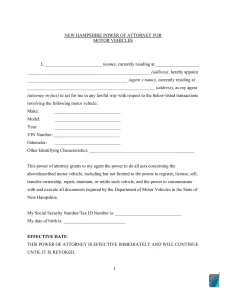New Hampshire Motor Vehicle Power of Attorney Form
The New Hampshire vehicle power of attorney is specifically tailored to allow individuals to grant authority to another person to handle matters related to the titling, registration, and other related transactions for cars. These provisions are crucial for residents or vehicle owners who might not be able to present themselves for these transactions. This power of attorney template is necessary for conducting various transactions at the New Hampshire Division of Motor Vehicles (DMV) without the vehicle owner’s direct involvement.

Build Your Document
Answer a few simple questions to make your document in minutes
Save and Print
Save progress and finish on any device, download and print anytime
Sign and Use
Your valid, lawyer-approved document is ready
The validity of New Hampshire POA forms hinges on strict adherence to signature and notarization requirements as outlined in RSA 564-E:105, further contextualized by RSA 564-E:106. To be legally recognized, the POA must be signed by the principal or by another individual directed to do so in the principal’s presence. Additionally, it must be notarized to confirm the principal’s identity.
New Hampshire Motor Vehicle Power of Attorney Form Details
| Document Name | New Hampshire Motor Vehicle Power of Attorney Form |
| State Form Name | New Hampshire Title 5 Form |
| Relevant Link | New Hampshire Division of Motor Vehicles |
| Avg. Time to Fill Out | 10 minutes |
| # of Fillable Fields | 23 |
| Available Formats | Adobe PDF |
Filling Out New Hampshire Vehicle POA
Before starting, ensure you have all the necessary information about the vehicle and the person you designate as your attorney-in-fact. The form must be filled out correctly to avoid any legal complications.
1. Enter the Date
Write the date at the top of the form where “Date” is indicated. This is the date you are filling out the POA.
2. Identify the Grantor(s)
In the space provided, print the name(s) of the individual(s) granting the power of attorney. If the vehicle is owned jointly, both owners must be listed.
3. Appoint Your Attorney-in-Fact
Enter the full name of the person you are appointing as your attorney-in-fact in the space provided. This individual will have the authority to act on your behalf for the vehicle-related matters specified.
4. Vehicle Information
Fill in the vehicle’s year, make, and Vehicle Identification Number (VIN) in the respective fields. This information must be accurate and match the details on the vehicle’s title and registration documents.
5. Owner’s Signature and Date
Each owner must print their name, sign, and date next to their printed name. Ensure that the signatures match those on the vehicle’s title, as discrepancies can delay processing.
6. Provide Contact Information
Include the address, city/state, zip code, and telephone number where indicated. This information may be used for any correspondence related to the POA.
7. Notarization
The form must be signed in the presence of a Notary Public or Justice of the Peace. The notary will fill in the county, the date, and their details and witness and verify the signatures.
8. Finalize the Form
After completing all sections and notarization, review the form to ensure all information is correct and no sections have been inadvertently skipped. The form is now ready to be used for any vehicle-related legal transactions as specified.
